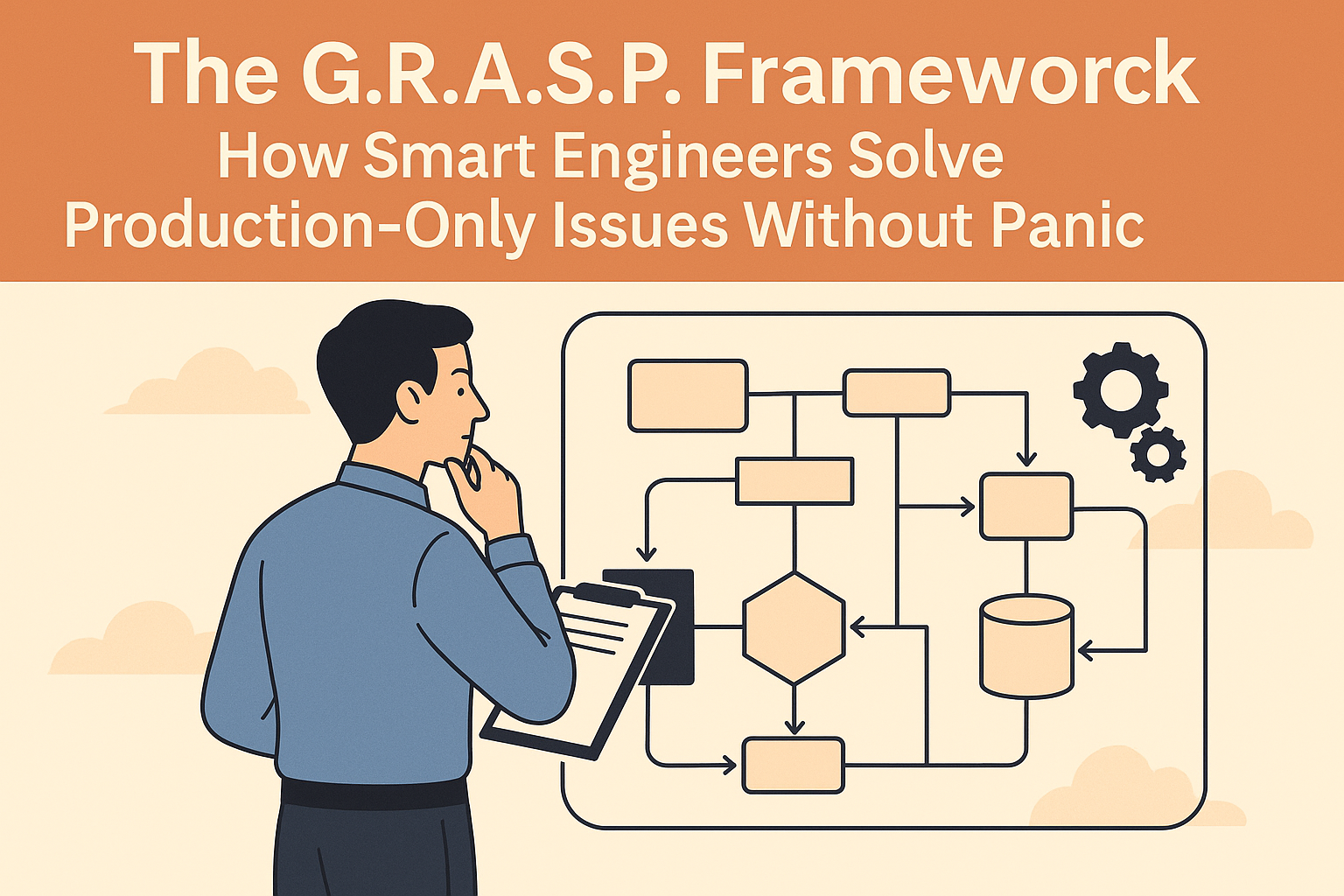The G.R.A.S.P. Framework: How Smart Engineers Solve Production-Only Issues Without Panic
Prod-only bugs don’t need chaos. This article shows how the G.R.A.S.P. framework helps engineers debug like owners, save hours of guesswork, and build career trust.

If you’ve been in tech long enough, you know this feeling:
Everything works in dev.
It works in staging.
But it fails in production — and only in production.
You’ve restarted services. Cleared caches. Rebuilt containers. Added log lines. Stared at the screen.
And still — the issue lives on, hiding like a shadow.
This is what I call a “production-only” issue — a bug that mocks all your tools, all your confidence, and all your safe environments.
And what’s worse?
In the eyes of the business, the clock is ticking. Customers are impacted. Leadership wants answers. And suddenly, you go from being a good developer to the person everyone’s waiting on.
Here’s the truth:
🔹 Production-only bugs are not rare.
🔹 They’re not just edge cases.
🔹 They’re a signal that we need a new approach — one that doesn’t rely on lucky breaks or scattered logs.
That’s why I built the G.R.A.S.P. framework.
Not just to solve these bugs.
But to give developers a calm, reliable, and repeatable system for dealing with them — and in the process, build a reputation as the person who doesn’t panic when prod breaks.
Let’s dive in.
🚨 What is the G.R.A.S.P. Framework?
G.R.A.S.P. is a simple, 5-part debugging framework designed for issues that only show up in production.
Each letter stands for a step in the journey:
| 🔤 | Step | Goal |
|---|---|---|
| G | Gather Ground Reality | Get crystal-clear on what’s really happening in prod |
| R | Replay or Recreate Safely | Simulate the scenario in a controlled, testable environment |
| A | Analyze Environment Gaps | Compare prod with staging/dev to find what’s different |
| S | Shadow the Behavior | Add smart logs/tracing to observe the system in real-time |
| P | Pinpoint and Patch | Identify the root cause and fix it with confidence |
This framework is especially powerful for mid-level and senior devs who:
- Own complex systems
- Need to respond to incidents fast
- Want to build trust with their team and org
And now let’s walk through each step — in the calmest, clearest way possible — so you can own this process end-to-end.
🔍 G – Gather Ground Reality
“Before you fix anything, make sure you even understand what’s broken.”
This sounds basic, but in 70% of prod incidents I’ve seen, teams don’t start by capturing the exact ground reality. They start by assuming. Guessing. Trying whatever worked last time.
What does “Ground Reality” actually mean?
It means reconstructing the moment of failure as closely as possible.
You want to know:
- When did it start?
- How often is it happening?
- What exact error is thrown (with full stack trace)?
- Which users are impacted?
- Is it tied to a specific payload? Region? API call?
- What changed recently in the code, infra, or data?
🎯 Tip: Always tag logs with RequestID, UserID, FeatureFlag, and TraceID — they’re your flashlight in the production jungle.
Tools that help you gather ground reality:
- Log aggregators: Datadog, ELK Stack, Splunk, Sumo Logic
- Alert platforms: PagerDuty, Opsgenie, New Relic
- APMs: AppDynamics, Dynatrace, Azure App Insights
- Custom log dashboards — especially if built for incidents
🧠 Mindset Tip: Be patient. Don’t assume. Investigate like a detective.
🧰 Bonus Tool: Have a production_issue_template.md — a simple template for your team to fill out during incidents. It improves speed, consistency, and handovers.
🧪 R – Replay or Recreate Safely
“If you can recreate it, you can debug it. If you can’t, you’ll always be guessing.”
This is the golden step.
If you can safely reproduce the issue in staging or locally, you gain full control.
But here’s the challenge — prod-only bugs often depend on:
- Data differences
- Timing issues
- Infra quirks (load balancer, region, concurrency)
- Env-specific settings
So the trick is to simulate the real-world context as much as possible:
How to do it:
- Export real prod payloads (anonymize if needed)
- Clone data snapshots or configs into a sandbox
- Copy environment variables, secrets, feature flags
- Match the same job schedule or triggers
🔒 Safety Tip: Never recreate on actual prod. Use flags, shadow environments, or isolated replicas.
💡 Smart Practice: Maintain a staging-tools/ folder in your repo for helpers like:
- Repro payload scripts
- Infra emulators (queues, S3, SQL snapshots)
- Chaos testing toggles
📊 Company ROI: The faster you can reproduce issues, the fewer cycles are wasted in meetings, reassignments, and wild goose chases.
🧩 A – Analyze Environment Gaps
“If it works in dev and not in prod, something must be different.”
This step is often skipped. But it’s where many bugs hide.
You’re not debugging your code now.
You’re debugging the environment.
What to compare:
- Env variables: API keys, toggles, region settings
- Infra: CPU/memory limits, container behavior, logging agents
- Middleware: Version mismatches, config files
- Data: Huge datasets in prod vs dummy data in staging
- Load: Concurrent usage, queue depth, memory pressure
🔍 Use this mindset: “What assumption did we make that’s only true in staging?”
🧰 Tools:
env-diff.shscripts- Side-by-side YAML compare (K8s, Docker, etc.)
- Cloud console snapshots
- Infra-as-code audits (Terraform, ARM Templates)
💼 Career Boost Insight: Engineers who think beyond their laptop and understand env gaps are seen as system thinkers — not just coders.
👀 S – Shadow the Behavior
“Sometimes, the only way to know what’s going wrong — is to watch it in action.”
Once you’ve reproduced or found clues, the next step is to shadow the failing system.
Not with brute force logs, but with smart, surgical tracing.
What does it mean to “shadow”?
- Add debug logs only where needed
- Use trace IDs across microservices
- Turn on verbose logging with flags
- Add metrics around suspected areas (timing, retries, status codes)
⚠️ Caution: Don’t break prod in the name of observing it. Your job is to watch without disturbing.
🎯 Tools to use:
- Distributed tracing: OpenTelemetry, Zipkin, Jaeger
- Feature-flagged logging (e.g.,
if (debugMode) log(...)) - CloudWatch custom metrics
- Canary routes or debug endpoints (guarded by roles/flags)
🏆 Org Benefit: Shadowing helps reduce future incident time too — you’re not just fixing once, you’re investing in faster resolution next time.
🧠 Mindset Tip: Think like a security camera — clear, quiet, and always pointing at the right angle.
🎯 P – Pinpoint and Patch
“This is where you finish the job — not just by fixing the bug, but by fixing the system.”
Now you have:
- Full picture of what’s going wrong
- A reliable repro setup
- Observations from live traces
- Differences in prod vs dev
It’s time to isolate the root cause and solve it.
But don’t just stop at the bug fix.
Go one step beyond.
What to do now:
- Fix it — with a guardrail in place
- Add a regression test or integration test
- Update KT (Knowledge Transfer) notes
- Write a postmortem (short, focused)
- Add alerting/monitoring if missing
- Inform stakeholders — clearly, briefly
📘 Career Insight: This is where you show that you’re not a “just fix and move on” dev. You’re a builder of resilient systems.
💡 Share how you solved it in team slack/email.
It builds trust, spreads learning, and shows leadership.
📊 Company ROI: One well-handled prod issue saves dozens of person-hours, reduces customer churn, and prevents panic culture.
🧠 Wrap-Up: Why G.R.A.S.P. Works
Production-only bugs are some of the hardest problems in tech.
But they’re also your biggest opportunity:
- To prove calm under pressure
- To demonstrate real-world systems thinking
- To reduce fire-fighting for the whole team
- To grow into the go-to problem solver
And that’s what G.R.A.S.P. gives you:
A calm, confident, repeatable way to:
✅ Investigate
✅ Understand
✅ Reproduce
✅ Monitor
✅ Fix
✅ Prevent
If you're a mid-level or senior engineer, this is your superpower.
And if you're mentoring juniors — this is the best thing you can teach them.
So next time production goes sideways, don’t just panic or patch.
G.R.A.S.P. it.
🔗 Want more frameworks like this? Visit thetruecode.com
💬 Let’s Connect
Enjoyed this article or have a perspective to share? Let’s connect on LinkedIn.

